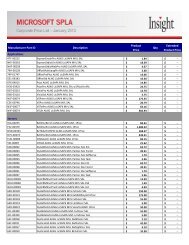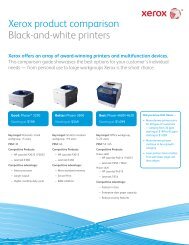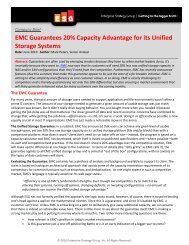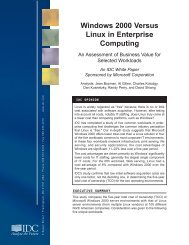Building Cloud-Optimized Data Center Networks - Insight
Building Cloud-Optimized Data Center Networks - Insight
Building Cloud-Optimized Data Center Networks - Insight
Create successful ePaper yourself
Turn your PDF publications into a flip-book with our unique Google optimized e-Paper software.
<strong>Building</strong> <strong>Cloud</strong>-<strong>Optimized</strong> <strong>Data</strong> <strong>Center</strong> <strong>Networks</strong><br />
HP’s FlexNetwork Architecture Meets the Stringent Performance, Security and Agility<br />
Demands of <strong>Cloud</strong> Computing<br />
Technical white paper<br />
Table of contents<br />
Executive Summary ....................................................................................................................... 2<br />
Accelerating Business Innovation with <strong>Cloud</strong> Computing ................................................................... 2<br />
HP <strong>Cloud</strong>System – A Single Platform for Private, Public and Hybrid <strong>Cloud</strong>s ......................................... 3<br />
<strong>Cloud</strong>-<strong>Optimized</strong> <strong>Data</strong> <strong>Center</strong> Network Requirements ....................................................................... 3<br />
HP FlexNetwork - An Architectural Blueprint for <strong>Cloud</strong>-<strong>Optimized</strong> Networking ..................................... 6<br />
FlexFabric: <strong>Cloud</strong>-<strong>Optimized</strong> <strong>Data</strong> <strong>Center</strong> <strong>Networks</strong> ..................................................................... 6<br />
Securing the FlexFabric: HP TippingPoint Secure Virtualization Framework ...................................... 9<br />
FlexBranch: <strong>Cloud</strong>-<strong>Optimized</strong> Wide Area <strong>Networks</strong> .................................................................... 10<br />
FlexManagement: Unified Virtual and Physical Management with HP Intelligent Management <strong>Center</strong>11<br />
Future Trends and Emerging Solutions ........................................................................................... 11<br />
More Scalable and Robust <strong>Data</strong> <strong>Center</strong> <strong>Networks</strong> – TRILL and SPB ................................................ 11<br />
Improved Virtual Edge Management – VEPA .............................................................................. 11<br />
Summary ................................................................................................................................... 12<br />
The Fast-Track Secret to Success in the <strong>Cloud</strong>: HP Services............................................................... 12<br />
For More Information .................................................................................................................. 13
2<br />
Executive Summary<br />
Enterprises are turning to the <strong>Cloud</strong> to improve business agility, reduce expenses and accelerate business innovation.<br />
<strong>Cloud</strong> computing redefines the way IT assets are deployed and consumed and dramatically affects the way data<br />
center networks are architected and managed. Conventional hierarchical data center networks built to support<br />
traditional siloed IT architectures can’t meet the security, agility and price/performance requirements of virtualized<br />
cloud computing environments. Public cloud service providers and enterprises deploying private clouds must<br />
implement flatter, simpler data center networks to support the bandwidth-intensive, delay-sensitive server-to-server<br />
traffic flows that accompany cloud computing. Enterprises must also evolve and adopt new management systems and<br />
practices to administer and secure virtual resources and orchestrate on-demand services.<br />
HP <strong>Cloud</strong>System is the industry’s most complete, integrated, and open system for building and managing services<br />
across private, public and hybrid environments. <strong>Cloud</strong>System leverages best-of-breed HP FlexNetwork networking<br />
solutions that enable the construction of simpler and more efficient data center networks with fewer layers and greater<br />
port densities to address the increased price/performance and scalability demands of these new highly virtualized<br />
data centers. In addition, the solutions deliver advanced management capabilities that unify security and<br />
administration across virtualized and physical resources and accelerate the delivery of on-demand applications and<br />
services.<br />
This white paper reviews the impact of cloud computing on data center networks and describes HP’s approach to<br />
building simpler, more secure and automated networks that fully meet the stringent performance, security, reliability<br />
and agility demands of the new data center in the <strong>Cloud</strong>.<br />
Accelerating Business Innovation with <strong>Cloud</strong> Computing<br />
Businesses of every size and industry are looking to the <strong>Cloud</strong> to boost business agility, reduce expenses and risks,<br />
and improve business innovation. <strong>Cloud</strong> computing provides on-demand access to an elastic pool of shared<br />
computing, storage and networking resources over a private IP network or the Internet. <strong>Cloud</strong> services can be<br />
deployed in several different ways.<br />
In a public cloud model, a service provider establishes a cloud-based service as a commercial offering. IT assets are<br />
shared, and services are provided to multiple enterprises, often on a per-use basis. By leveraging the experience and<br />
capital investments of a trusted cloud service provider, enterprises can reduce CAPEX, respond more quickly to<br />
rapidly evolving business requirements, and focus valuable IT resources on business innovation rather than underlying<br />
IT infrastructure. According to IDC the overall market for public cloud services will grow from $16.5 billion in 2009 to<br />
more than $55 billion by 2014.<br />
In a private cloud deployment model, services are delivered to users and groups within an individual enterprise. An<br />
enterprise IT organization may set up a private cloud to provide on-demand applications and services to internal<br />
consumers and business units. By implementing private clouds, enterprises can reduce CAPEX and OPEX by<br />
leveraging economies of scale and eliminating redundancies plus allow business units to improve business agility and<br />
concentrate on business innovation rather than underlying IT services.<br />
In a hybrid model an enterprise employs a combination of private and public cloud services - sometimes in<br />
conjunction with traditional on-premises IT solutions. Many larger enterprises are adopting hybrid deployment models.<br />
<strong>Cloud</strong> computing alters traditional data center traffic flows, increases bandwidth and performance demands, and<br />
introduces new security, SLA and service orchestration requirements. Enterprises and service providers must implement<br />
more agile, efficient and scalable data center networks and adopt new management systems and practices to support<br />
the move to cloud computing.
HP <strong>Cloud</strong>System – A Single Platform for Private, Public and<br />
Hybrid <strong>Cloud</strong>s<br />
HP <strong>Cloud</strong>System is the industry’s most complete, integrated and open system for building and managing cloud<br />
services. Only HP delivers a comprehensive, integrated cloud solution on a single platform, with all the attributes so<br />
prized by CIOs, service providers and IT professionals.<br />
Based on proven, market-leading HP <strong>Cloud</strong> Service Automation and Converged Infrastructure, HP <strong>Cloud</strong>System<br />
combines servers, storage, networking, and security together with automated system and hybrid service delivery<br />
management. The result is a complete cloud solution that’s prepared to fulfill the promise of “cloud driven” services<br />
and revenue for enterprises and service providers alike in minutes, and manages the services throughout their<br />
lifecycle.<br />
HP <strong>Cloud</strong>System is the product of HP’s experience in delivering industry-leading automation, application<br />
management, and converged infrastructure capabilities. It enables customers to build, manage, and consume cloud<br />
services across private clouds, public clouds, and traditional IT environments—without having to know, or care,<br />
whether those services come from HP <strong>Cloud</strong>System’s own “on-premises” resources or from the public domain.<br />
HP <strong>Cloud</strong>System Matrix is the core <strong>Cloud</strong>System platform. It is built on our renowned, field-proven BladeSystem<br />
platform with HP Virtual Connect and <strong>Cloud</strong> Service Automation products. That core platform is fully extensible via<br />
HP’s Converged Infrastructure portfolio, including HP 3PAR utility storage, HP TippingPoint Security, and core-to-edge<br />
HP Networking.<br />
<strong>Cloud</strong>-<strong>Optimized</strong> <strong>Data</strong> <strong>Center</strong> Network Requirements<br />
Today’s data center networks were designed to support conventional siloed IT architectures in which servers are<br />
dedicated to specific functions or organizations and the vast majority of traffic flows in and out of the data center.<br />
Most data center networks are based on hierarchical designs comprised of an access tier, an aggregation tier and a<br />
core tier (figure 1).<br />
Figure 1: Customary three-tier data center network architecture<br />
Core Tier<br />
Aggregation Tier<br />
Access Tier<br />
Dedicated Servers<br />
The access tier is made up of cost-effective Ethernet switches connecting rack servers and IP-based storage devices<br />
(typically 10/100Mbps or 1GbE connections). The access switches are connected via Ethernet to a set of<br />
aggregation switches (typically 1/10GbE connections) which in turn are connected to a layer of core switches or<br />
routers that forward traffic to an intranet, the Internet and between aggregation switches. Layer 2 VLANs are typically<br />
implemented across the access tier and aggregation tier, and Layer 3 routing is implemented in the core. Bandwidth<br />
is typically over-provisioned in the access tier, and to a lesser extent in the aggregation tier.<br />
3
4<br />
The server infrastructure and the networking infrastructure are typically administered independently, by separate<br />
teams using distinct toolsets. Each server is typically dedicated to a specific function (i.e. Web server, application<br />
server, database server) and can be reasonably well protected using conventional security solutions such as intrusion<br />
prevention systems.<br />
Contemporary data center networks designed to support siloed IT architectures simply can’t meet the performance,<br />
security, availability and agility requirements of the <strong>Cloud</strong>. Public cloud service providers and enterprises deploying<br />
private clouds must implement simpler and more efficient networks that support the bandwidth-intensive, delaysensitive<br />
server-to-server traffic flows and stringent SLA and security demands that accompany cloud computing and<br />
they must adopt new management systems and practices to orchestrate on-demand services and administer and<br />
isolate virtual resources. Requirements for the new cloud-optimized data center network include the following:<br />
• Low-latency server-to-server connections: Today’s three-tier hierarchical networks aren’t well suited for high-volume<br />
server-to-server communications. Inter-server traffic is forced to traverse multiple layers of switches, and each switch<br />
adds latency to the connection (figure 2). Enterprises and service providers must implement flat, low-latency data<br />
center networks to accommodate the delay-sensitive, volume-intensive server-to-server traffic flows that accompany<br />
cloud computing models.<br />
Figure 2: Hierarchical networks aren’t well suited for server-to-server communications. Server-to-server traffic must traverse multiple<br />
layers of switches. Each hop adds delay.<br />
Aggregation<br />
Tier<br />
Access<br />
Tier<br />
Core<br />
Tier<br />
Server-to-server traffic flow endures five hops<br />
Latency<br />
• Greater performance and resiliency: Today’s hierarchical data center networks typically rely on some variant of the<br />
spanning tree protocol (STP) for resiliency. STP is designed to allow only one active path from one switch to<br />
another, regardless of how many actual connections might exist in the network. If the active path fails, the protocol<br />
automatically selects a backup path. STP can take several seconds to recover from link failures and is not well<br />
suited for delay-sensitive applications. <strong>Cloud</strong> computing requires more efficient and resilient network designs that<br />
make full use of networking resources (no idle backup paths) and recover from failures in milliseconds to meet<br />
stringent resiliency requirements.<br />
• Large layer 2 domains: VM migration (VMotion/Live Migration) - the ability to seamlessly move VMs from one<br />
physical server to another without impacting applications or users - is driving the requirement for large-scale Layer<br />
2 domains that offer high throughput and low latency. VM migration is critical for executing routine maintenance,<br />
business continuity and disaster recovery functions in the <strong>Cloud</strong>.<br />
• Higher bandwidth at the server edge: Blade servers and server virtualization pack more and more computational<br />
power into smaller and smaller form-factors - increasing bandwidth demands at the server edge, driving<br />
requirements for new switching solutions that offer better performance and greater port densities.
• Stringent availability requirements: For public cloud service providers the data center is the lifeblood of the<br />
business. Providers must deliver carrier-class network services to honor SLA contracts and meet core business<br />
objectives. Similarly, IT organizations responsible for private cloud services must deliver predictable and reliable<br />
network services to support mission-critical business applications, address internal service level commitments, and<br />
meet P&L objectives.<br />
• Unified management: Server virtualization creates a new ‘virtual edge’ that blurs the traditional boundaries<br />
between network and server administration and introduces a variety of operational challenges. New tools are<br />
required for efficiently administering virtual switches, servers and connections; for orchestrating on-demand<br />
applications and services, and for ensuring SLAs and enforcing service policies as VMs migrate across the data<br />
center.<br />
• Virtualization-aware security: The virtual edge is beyond the scope of existing security systems and practices. In<br />
contemporary data centers, distinct workloads (database, application, web-hosting) and tenants are deployed on<br />
discrete physical servers. Workload-to-workload communications always occurs over physical connections and can<br />
be secured using conventional intrusion prevention tools (figure 3). With server virtualization, workloads can<br />
communicate over virtual connections within the same server in a manner transparent to existing network-based<br />
intrusion prevention systems. <strong>Cloud</strong> service providers must implement new ‘virtualization-aware’ security solutions to<br />
police intra-server communications flows, protect virtual resources and partition multi-tenant environments.<br />
Figure 3: Conventional security tools and practices built around physical servers and physical switches can’t safeguard intra-server,<br />
workload-to-workload communications.<br />
Web<br />
App<br />
DB<br />
Conventional Multi-tenant<br />
Environment<br />
IPS<br />
Web<br />
App<br />
Workload-to-workload traffic flows over<br />
physical connections between distinct<br />
servers<br />
DB<br />
Tenant A Tenant B<br />
Web<br />
(tenant A)<br />
Virtualized Environment<br />
?<br />
App<br />
(tenant A)<br />
Hypervisor<br />
Server<br />
Web<br />
(tenant B)<br />
IPS<br />
Virtual Switch<br />
App<br />
(tenant B)<br />
Workload-to-workload traffic flows over<br />
virtual connections within the same server<br />
5
6<br />
HP FlexNetwork - An Architectural Blueprint for <strong>Cloud</strong>-<br />
<strong>Optimized</strong> Networking<br />
HP FlexNetwork architecture - HP’s blueprint for cloud-optimized networking - enables enterprises to align their<br />
networks with their business needs - even as needs change. With FlexNetwork, enterprises can segment their<br />
networks into the four interrelated modular building blocks: FlexFabric, FlexCampus, FlexBranch and<br />
FlexManagement (figure 4).<br />
Figure 4: HP FlexNetwork lets enterprises align networks with business needs<br />
FlexManagement<br />
Converges<br />
Network<br />
Management &<br />
Orchestration<br />
Industry’s only network architecture converging data center, campus, branch<br />
FlexFabric FlexCampus FlexBranch<br />
Converges and secures data<br />
center network, compute,<br />
and storage in the physical<br />
and virtual worlds<br />
Converges wired and<br />
wireless networks to deliver<br />
secure identity-based<br />
access<br />
FlexFabric FlexCampus FlexBranch<br />
FlexManagement<br />
FlexNetwork Architecture<br />
Open Scalable Secure Agile<br />
Converges network<br />
functionality, security and<br />
services for simplicity<br />
Consistent<br />
experience<br />
FlexNetwork<br />
Architecture<br />
HP FlexFabric and HP FlexCampus enable the construction of flat, low-latency data center and campus networks with<br />
fewer layers, less equipment and cabling, and greater port densities. HP FlexBranch includes comprehensive WAN<br />
optimization and routing solutions for delivering dynamic cloud-based services to geographically-distributed<br />
enterprises. HP FlexManagement provides a unified view into the virtual and physical network infrastructure that<br />
accelerates application and service delivery, simplifies operations and management, and boosts network availability.<br />
HP FlexNetwork lets enterprises securely deploy and centrally orchestrate cloud-optimized architectures that scale<br />
from the data center to the network edge. It enables the construction of flatter, simpler data center networks to support<br />
the bandwidth-intensive, delay-sensitive server-to-server virtual machine and workload traffic flows that accompany<br />
cloud computing, and it provides rich management tools for administering and securing virtual resources, and<br />
orchestrating on-demand services.<br />
FlexFabric: <strong>Cloud</strong>-<strong>Optimized</strong> <strong>Data</strong> <strong>Center</strong> <strong>Networks</strong><br />
The <strong>Cloud</strong> fundamentally changes the ways in which applications are deployed, administered and consumed. <strong>Cloud</strong><br />
computing makes heavy use of server virtualization technology which reshapes data center traffic flows, and blade<br />
server technology which increases bandwidth demands at the server edge, and drives requirements for denser<br />
switching equipment and more efficient network designs. HP FlexFabric helps cloud providers and enterprises<br />
deploying private clouds implement flatter, simpler data center networks to support the bandwidth-intensive, delaysensitive<br />
server-to-server traffic flows that accompany cloud computing.
FlexFabric supports a wide range of network designs to meet diverse customer requirements (figure 5). Customers<br />
looking to protect investments in legacy core infrastructure can implement a three-tier traditional network design, and<br />
deploy cost-effective HP A-Series Top-of-rack server edge and aggregation platforms that interoperate with their<br />
existing core switches. This approach allows customers to preserve existing assets and gradually migrate to a more<br />
agile network design over time while enjoying the benefits of IRF switch virtualization and cost-effective, energyefficient<br />
HP A-Series switches in the server edge and aggregation layers.<br />
Customers looking to reduce cost and complexity can implement a two-tier collapsed network design that completely<br />
eliminates a dedicated aggregation layer. These designs leverage HP Virtual Connect or HP A58XX series switches at<br />
the server edge along with highly-scalable HP A12500 series core switches as a collapsed core/aggregation layer.<br />
These flat network designs ensure direct-flight server-to-server performance while dramatically reducing network port<br />
counts. A two-tier collapsed design also simplifies and streamlines network management, and reduces capital<br />
expense and energy consumption.<br />
Customers can reduce CAPEX and OPEX even further by implementing an optimized two-tier collapsed network<br />
design using HP BladeSystem servers and HP Virtual Connect. This solution provides the ultimate in simplification,<br />
agility and cost optimization.<br />
Figure 5: FlexFabric supports a range of network designs to support diverse customer requirements<br />
Legacy core<br />
HP aggregation<br />
A7500 + IRF<br />
HP server edge<br />
A58xx + IRF<br />
Blade/Rack Servers<br />
<strong>Optimized</strong> 3-tier<br />
INVESTMENT<br />
PROTECTED<br />
HP collapsed core +<br />
aggregation<br />
A12500 + IRF<br />
HP server edge<br />
A58xx + IRF<br />
Blade/Rack Servers<br />
Simplified 2-tier<br />
COMPLEXITY<br />
REDUCED<br />
HP collapsed core<br />
+ aggregation<br />
A12500 + IRF<br />
HP BladeSystem<br />
servers and Viral<br />
Connect<br />
<strong>Optimized</strong> 2-tier<br />
VIRTUALIZED, CLOUD<br />
ENABLED<br />
HP A-Series Ethernet Switches and innovative Intelligent Resilient Framework (IRF) technology enable flat, low-latency<br />
network designs to support highly virtualized data centers. In addition, A-Series switches offer industry-leading server<br />
edge port density to meet the increased bandwidth demands that accompany the implementation of server<br />
virtualization and blade server technology.<br />
HP A-Series Ethernet Switches<br />
HP A-Series 12500 core switches leverage the latest generation of ASICs and a fully non-blocking design based on a<br />
CLOS architecture to deliver ultimate performance, density and scalability. The product family delivers 6.66Tbps<br />
performance and offers very high port density today (512 10GbE or 128 10GbE ports per rack) with support for<br />
40GbE and 100GbE connections in the future.<br />
HP A-Series 58XX ToR switches leverage cut-through switching technology and a high-availability architecture to<br />
deliver line-rate, low-latency performance and outstanding reliability at the server edge. The product family’s high port<br />
density (up to 24 10GbE ports per unit) meets escalating bandwidth demands at the server edge.<br />
7
8<br />
Virtualization-<strong>Optimized</strong> Server Edge Solutions<br />
HP provides flexible solutions for delivering high-performance server-to-server connectivity at the server edge (figure<br />
6). HP solutions can directly interconnect hundreds of virtual machines at the edge of the network, eliminating<br />
unnecessary network hops, reducing latency and optimizing performance for high-volume server-to-server traffic flows.<br />
For traditional top-of-rack server edge installations, HP A-Series 58XX ToR switches can be deployed with IRF<br />
virtualization technology to provide high-throughput, low-latency server-to-server connectivity at the server edge. With<br />
IRF, multiple switches can be virtualized and logically combined to enable low-latency, ultra-resilient virtual switching<br />
fabrics comprising hundreds or even thousands of 1GbE or 10GbE switch ports–all managed via a single IP address.<br />
For BladeSystem deployments, HP Virtual Connect delivers direct server-to-server connectivity within the rack, enabling<br />
wire-speed, machine-to-machine communications for delay-sensitive, bandwidth-intensive traffic. In addition, HP<br />
Virtual Connect Flex-10 and FlexFabric modules can be leveraged to dynamically fine-tune application-specific<br />
performance across server and storage networks to improve scale and make best use of shared connectivity<br />
resources.<br />
Figure 6: High performance server-to-server connectivity: HP A-Series ToR Switches with IRF for Rack Servers; HP Virtual Connect for<br />
Blade Servers<br />
A-Series ToR<br />
Switches with IRF<br />
IRF Virtual Connect<br />
Direct-flight<br />
Rack Servers<br />
HP Virtual Connect<br />
Direct-flight<br />
Blade Servers<br />
Collapsed Two-tier <strong>Data</strong> <strong>Center</strong> Network Architecture<br />
In the core of the network, HP A-Series 12500 switches can be deployed in conjunction with IRF to completely<br />
eliminate the aggregation layer found in conventional three-tier data center networks (figure 7). IRF overcomes the<br />
limitations of legacy spanning tree networks by fully leveraging all network connectivity (no inactive backup paths)<br />
and by providing rapid failover to dramatically improve network utilization and performance in the network core.
Figure 7: A two-tier network design enables direct-flight server-to-server connectivity while reducing cost and complexity.<br />
A-Series ToR<br />
Switches with IRF<br />
A-Series Core<br />
Switches with IRF IRF<br />
IRF Virtual Connect<br />
W 75% or more of traffic<br />
Direct-flight<br />
Rack Servers Blade Servers<br />
HP Virtual Connect<br />
A collapsed, two-tier data center network architecture enables direct-flight server-to-server performance, requires<br />
significantly fewer connections and port counts (no aggregation switches), streamlines provisioning and network<br />
management, and reduces capital expense and energy consumption. In addition, these two-tier networks provide<br />
large Layer 2 domains to enable VM migration across the data center (move workloads from one server to another<br />
server in the same VLAN/IP subnet.)<br />
Securing the FlexFabric: HP TippingPoint Secure Virtualization Framework<br />
HP TippingPoint Secure Virtualization Framework (SVF) enables unified security across virtualized and physical<br />
domains, safeguarding VM-to-VM as well as inter-server and inter-network traffic in a common platform. The<br />
framework streamlines administration and reduces operations expenses by centralizing and automating security<br />
management functions. Administrators define rich, infrastructure-wide security policies which are implemented across<br />
virtual machines and virtual switches in a transparent fashion. The solution helps cloud service providers and<br />
enterprises implementing public clouds address the unique challenges associated with partitioning distinct user<br />
communities and securing multi-tenant environments.<br />
SVF brings best-of-breed TippingPoint intrusion prevention, threat mitigation and security management features to the<br />
virtual edge, safeguarding IT assets and optimizing service availability. HP TippingPoint vController - an integral SVF<br />
component – works with an HP TippingPoint N-Platform IPS to provide high performance intrusion prevention for a<br />
virtualized server. A software-based solution that is easily installed in a virtualized server, vController directs virtual<br />
machine traffic to an N-Platform where robust intrusion protection services are applied with line-rate performance<br />
(figure 8). The solution segregates virtual resources and inspects and polices intra-server traffic flows providing<br />
consistent, unified security across virtualized and physical data center network infrastructures.<br />
HP’s high-performance security solutions allow enterprises to support dynamic traffic demands and service flows<br />
without adding devices and complexity or compromising security. Enterprise private cloud data centers may “burst” to<br />
public clouds from time-to-time to accommodate demand spikes. They must ensure real-time protection of both their<br />
private cloud and the virtual machines delivering burst capacity in the public cloud. HP TippingPoint’s Secure<br />
Virtualization Framework delivers real-time security as virtual machines (VMs) are provisioned in the public cloud,<br />
automatically ensuring seamless, secure and context-aware protection, enabling enterprises to dynamically shift and<br />
re-allocate services without sacrificing security.<br />
E<br />
9
10<br />
Figure 8: Virtualization-aware security: HP TippingPoint IPS + vController<br />
Clean<br />
Traffic<br />
Hypervisor<br />
OS<br />
App<br />
vSwitch<br />
TippingPoint vController<br />
Virtual Machines<br />
OS<br />
App<br />
Network<br />
Threats<br />
HP TippingPoint<br />
IPS<br />
FlexBranch: <strong>Cloud</strong>-<strong>Optimized</strong> Wide Area <strong>Networks</strong><br />
The <strong>Cloud</strong> transforms the way organizations deliver and consume IT services and alters traditional WAN traffic<br />
patterns. Many conventional enterprise WANs are based on a centralized architecture where branch office traffic is<br />
backhauled to a central corporate data center over a private IP network. Enterprises must evolve their WAN<br />
architectures to support the dynamic and distributed nature of cloud-based computing. FlexBranch provides flexible<br />
options for evolving enterprise WANs to support the <strong>Cloud</strong>.<br />
HP offers a wide-ranging family of branch and remote office switching and routing solutions that address diverse<br />
performance, price and scalability requirements and offer customers a broad set of options. Using the HP E5400<br />
Switch series enterprises can evolve their WANs to support a mix of centralized and distributed services – all secured<br />
and managed in a unified fashion. For example, with the HP E5400 a branch office could be configured to enable<br />
the delivery of certain cloud-based services over a public Internet connection and other services over a private<br />
network connection all under the control of a centralized policy management system. The connections can be<br />
adapted dynamically to accommodate shifting demands or service delivery models without compromising security or<br />
service integrity. For example an enterprise may shift certain services from a private cloud to a public cloud to<br />
accommodate peak workload demands, while preserving QoS and security policies.<br />
Ensuring optimal WAN performance is critical for delivering high quality end-user experiences. HP provides rich<br />
WAN optimization capabilities that help enterprises make the most efficient use of WAN resources to optimize<br />
application performance and end-user QoE. The HP E5400 leverages industry-leading Steelhead WAN optimization<br />
technology from Riverbed to accelerate application performance and ensure fast, reliable access to cloud-based<br />
applications and services. In addition the solution helps save money by reducing bandwidth consumption – packing<br />
more traffic onto existing WAN capacity.
FlexManagement: Unified Virtual and Physical Management with HP<br />
Intelligent Management <strong>Center</strong><br />
HP Intelligent Management <strong>Center</strong> (IMC) unifies physical and virtual network management and helps overcome the<br />
challenges of managing cloud computing environments, orchestrating on-demand services and administering the new<br />
virtual server edge. The solution provides a unified view into the virtual and physical network infrastructure that<br />
accelerates application and service delivery, simplifies operations and management, and improves network<br />
availability. Capabilities include:<br />
• Automatic discovery of virtual machines, virtual switches and their relationships with the physical network<br />
• VM and virtual switch resource management, including creation of virtual switches and port groups<br />
• Automatic and transparent configuration of virtual and physical network infrastructure<br />
• Unified performance and alarm monitoring of hosts, workloads and virtual switches<br />
• Topology views and status indicators for networks, workloads and virtual switches<br />
• Automatic reconfiguration of network policies as workloads migrate across the data center<br />
HP IMC can help eliminate service interruptions caused by virtual/physical network configuration errors; reduce<br />
administration and troubleshooting by providing unified management of physical and virtual network infrastructure<br />
through single pane of glass; and accelerate the delivery of on-demand applications and services by automating the<br />
configuration of virtual and physical network infrastructure.<br />
Future Trends and Emerging Solutions<br />
More Scalable and Robust <strong>Data</strong> <strong>Center</strong> <strong>Networks</strong> – TRILL and SPB<br />
Going forward, cloud computing will drive requirements for larger-scale, more reliable Layer 2 data center networks<br />
that can support increased workload mobility and greater numbers of server-to-server connections. HP is promoting<br />
standards-based approaches for building cloud-enabled data center networks and is actively involved in the IEEE<br />
802.1aq SPB (Shortest Path Bridging) and the IETF TRILL (Transparent Interconnection of Lots of Links) standardization<br />
efforts. Like IRF and Virtual Connect, SPB and TRILL overcome STP limitations, providing multi-path forwarding and<br />
localized failure resolution to enable full network utilization, fast network re-convergence and dramatically-improved<br />
Layer 2 scaling. HP intends to bring these standards-based technologies to market in future data center networking<br />
products.<br />
Improved Virtual Edge Management – VEPA<br />
Over time cloud computing will drive requirements for greater VM densities which will impact the performance and<br />
manageability of virtual switches. As more and more virtual machines are added to physical servers, less processing<br />
power will be available for networking tasks. In addition the challenges associated with configuring, troubleshooting<br />
and monitoring inter-VM communications will become more acute.<br />
HP has co-authored the IEEE Virtual Ethernet Port Aggregator (VEPA) proposal to provide a more explicit, accessible<br />
and robust infrastructure for managing connectivity at the virtual network edge. VEPA allows virtual switching to be<br />
extracted from the server, improving server performance and increasing the number of VMs that can run on each<br />
server. In addition, with VEPA, traffic flows within the virtual network edge can be brought into the physical network<br />
edge so network security and management policies can be reliably and efficiently implemented using standard<br />
networking tools and processes. HP intends to support VEPA-compatible solutions when they are commercially<br />
available.<br />
Ultimately, with VEPA and IMC, HP will deliver an automated, policy-driven, end-to-end orchestration framework for<br />
efficiently managing cloud-based resources and on-demand services.<br />
11
12<br />
Summary<br />
Enterprises are turning to the <strong>Cloud</strong> to accelerate business innovation, improve business agility and contain costs.<br />
<strong>Cloud</strong> computing reshapes the way applications are deployed and consumed and influences data center network<br />
designs. HP helps service providers and enterprises build unified, virtualization-optimized data center networks that<br />
meet the rigorous performance, scalability, availability and agility demands of the <strong>Cloud</strong>. HP <strong>Cloud</strong>System and HP<br />
FlexNetwork networking solutions deliver:<br />
• Flatter and more efficient data center networks with fewer layers, less equipment and cabling, and greater port<br />
densities<br />
• High performance, low latency intra-data center connectivity for VM migration and bandwidth-intensive server-toserver<br />
communications<br />
• Virtualization-aware security to partition multi-tenant environments and isolate virtual resources and intra-server<br />
communications flows<br />
• Optimal WAN performance for the highest quality end-user and application experiences and most efficient use of<br />
WAN resources.<br />
• Unified administration and service orchestration to accelerate the delivery of cloud-based applications and services<br />
• Multi-site, multi-vendor management to connect and control thousands of physical and virtual resources from a<br />
single pane of glass<br />
To learn more about how HP can help you build a cloud-optimized data center network, please contact your HP<br />
account manager or reseller.<br />
The Fast-Track Secret to Success in the <strong>Cloud</strong>: HP Services<br />
We believe that most enterprises are likely to reach a hybrid cloud model in the long term, and that the mix across<br />
internal, private, and public sourcing will evolve over time. That is why we recommend starting with a solid strategy<br />
covering all the different options. For the surest route to a successful cloud strategy and implementation, we<br />
encourage clients to engage HP Services to help align business and operational needs to their cloud strategy, while<br />
speeding the path to the cloud.<br />
Start with a holistic view and strategy<br />
Through HP <strong>Cloud</strong> Discovery Workshop, HP helps clients gain clarity on cloud concepts, identify the cloud initiatives<br />
that can work for their business, discuss how a Converged Infrastructure and HP <strong>Cloud</strong>System can lay the foundation<br />
for the cloud, and subsequently draw actionable steps. During this one-day workshop, senior HP consultants using<br />
highly visual displays cover topics such as cloud concepts, architecture, service portfolio, management, financials,<br />
governance, and more.<br />
Build a private cloud in 30 days<br />
Delivering a working private cloud service quickly and affordably is crucial; otherwise, IT risks the possibility that<br />
business stakeholders will deploy “shadow IT” services through the public cloud. HP <strong>Cloud</strong>Start helps avoid this<br />
scenario with speedy implementation (within 30 days after installation and startup) of the first private cloud services<br />
based on HP <strong>Cloud</strong>System Matrix. HP experts provide a series of workshops to shape and define the best<br />
<strong>Cloud</strong>System Matrix configuration, develop up to four compute services, and provide service definitions and<br />
specifications for those compute services. Clients also receive full automation design, implementation, and testing of<br />
the four compute services, so they quickly become production-ready consumable services. In tandem with HP<br />
<strong>Cloud</strong>System Matrix, HP <strong>Cloud</strong>Start provides the core features of a public cloud service, including:<br />
• Web-based self-service menus<br />
• Ability to activate a service in minutes<br />
• Flexibility to scale or cancel a service at any time<br />
• Behind-the-scenes IT service management<br />
• Real-time access to consumption and chargeback reports
© Copyright 2011 Hewlett-Packard Development Company, L.P. The information contained herein is subject to change without notice. The<br />
only warranties for HP products and services are set forth in the express warranty statements accompanying such products and services.<br />
Nothing herein should be construed as constituting an additional warranty. HP shall not be liable for technical or editorial errors or<br />
omissions contained herein.<br />
4AA3-7212ENW, Created September 2011<br />
For More Information<br />
HP Networking Solutions<br />
HP Networking Solutions home page<br />
http://www.hp.com/go/networking<br />
HP <strong>Cloud</strong> Solutions<br />
HP <strong>Cloud</strong> Solutions home page<br />
http://www.hp.com/go/cloud<br />
HP <strong>Cloud</strong>System<br />
HP <strong>Cloud</strong>System home page<br />
http://www.hp.com/go/cloudsystem<br />
HP A-Series Switches<br />
HP A-Series Switches data sheets and product details<br />
http://h17007.www1.hp.com/us/en/products/switches/index.aspx?tab=tab_A-Series<br />
HP Intelligent Resilient Framework<br />
HP IRF White Paper – Reducing network complexity, boosting performance with HP IRF technology<br />
http://h10144.www1.hp.com/docs/irf/irf.pdf<br />
HP Virtual Connect<br />
HP Virtual Connect data sheets and videos<br />
http://www.hp.com/go/virtualconnect<br />
HP TippingPoint Security<br />
HP TippingPoint data sheets and product details<br />
http://h17007.www1.hp.com/us/en/index.aspx?banner=security<br />
HP Intelligent Management <strong>Center</strong><br />
HP IMC data sheets and product details<br />
http://h17007.www1.hp.com/us/en/products/network-management/index.aspx
















